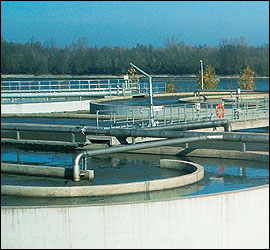 |
DABLAS funded report - Priority objectivesA new report funded by the DABLAS Task Force identifies the challenges that still exist in the basin, and prioritises them based on financial and environmental criteria. |
 |
The DABLAS project focuses on
implementing EU water-related directives, including the EU Water Framework
Directive, Urban Waste Water Directive, IPPC Directive and Nitrates
Directive. |
The Danube and Black Sea regions receive investments from a variety of sources, often on a country-by-country basis. A new report created by the ICPDR for the DABLAS Task Force has brought together, for the first time, all investment projects in the municipal, industrial and agricultural sectors for pollution control and nutrient reduction in the Danube basin areas, and measures to restore and protect wetlands and floodplains. Sabine Hoefnagel, a DABLAS staff member, says this report now makes it possible to better facilitate "understanding between the international financial institutions and the beneficiary countries and project proponents".
Helping investors help countries.
The report offers a rich source of data not published before. Investors
require detailed information to understand the efforts Danube countries
have undertaken to implement policies, directives and investment projects
in the last five years. "Donors will fund one project here and one
project there, but without comparative information, no one knows which projects
to fund or how much money has been spent," says Mihaela Popovici, Water
Management Technical Expert for the ICPDR Secretariat. "The report
was put together to assist these institutions, and to show the international
donor community the remaining needs in the area," she added.
Beginning with a list of potential investment projects and hot spots developed
by the ICPDR and the Black Sea Commission, projects were prioritised based
on a set of environmental and financial criteria. The database, designed
and developed by the ICDPR, identified over 350 investment projects for
municipal wastewater treatment, out of which 93 projects are fully financed.
Plan of action.
The report's evaluation is based on the implementation of the ICPDR Join
Action Programme (2000-2005), addressing municipal wastewater treatment
and other sector-specific projects such as industrial pollution control,
risk management and pollution control from point and non-point sources.
"This is the first time information on emissions, pollution reduction,
and investments have been systematically organised," says Popovici.
"The results will be used as a baseline for evaluating subsequent progress
at the national and regional levels," she adds.
While the report is not an end in itself, but it clearly shows the path
ahead in terms of investment information. "The DABLAS report,"
says Hoefnagel, "is
a step in the right direction for achieving better water quality for the
entire basin."
The DABLAS project map has been developed to identify remaining needs for
investments in the Danube River Basin. Click here to see this
map (PDF-file).